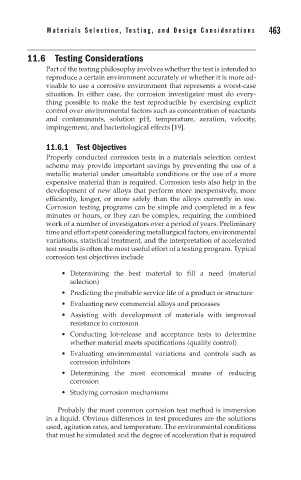Page 496 - Corrosion Engineering Principles and Practice
P. 496
462 C h a p t e r 1 1 M a t e r i a l s S e l e c t i o n , Te s t i n g , a n d D e s i g n C o n s i d e r a t i o n s 463
11.6 Testing Considerations
Part of the testing philosophy involves whether the test is intended to
reproduce a certain environment accurately or whether it is more ad-
visable to use a corrosive environment that represents a worst-case
situation. In either case, the corrosion investigator must do every-
thing possible to make the test reproducible by exercising explicit
control over environmental factors such as concentration of reactants
and contaminants, solution pH, temperature, aeration, velocity,
impingement, and bacteriological effects [19].
11.6.1 Test Objectives
Properly conducted corrosion tests in a materials selection context
scheme may provide important savings by preventing the use of a
metallic material under unsuitable conditions or the use of a more
expensive material than is required. Corrosion tests also help in the
development of new alloys that perform more inexpensively, more
efficiently, longer, or more safely than the alloys currently in use.
Corrosion testing programs can be simple and completed in a few
minutes or hours, or they can be complex, requiring the combined
work of a number of investigators over a period of years. Preliminary
time and effort spent considering metallurgical factors, environmental
variations, statistical treatment, and the interpretation of accelerated
test results is often the most useful effort of a testing program. Typical
corrosion test objectives include
• Determining the best material to fill a need (material
selection)
• Predicting the probable service life of a product or structure
• Evaluating new commercial alloys and processes
• Assisting with development of materials with improved
resistance to corrosion
• Conducting lot-release and acceptance tests to determine
whether material meets specifications (quality control)
• Evaluating environmental variations and controls such as
corrosion inhibitors
• Determining the most economical means of reducing
corrosion
• Studying corrosion mechanisms
Probably the most common corrosion test method is immersion
in a liquid. Obvious differences in test procedures are the solutions
used, agitation rates, and temperature. The environmental conditions
that must be simulated and the degree of acceleration that is required

